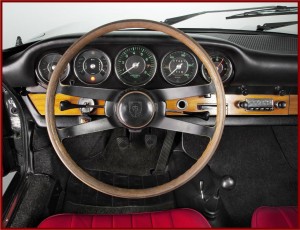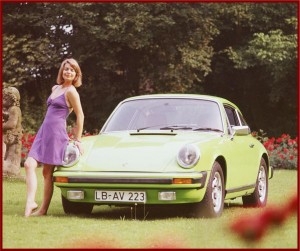
Porsche has an amazing history, building from what started out as essentially a re-bodied Volkswagen bug.
More than 820,000 Porsche 911 models have been built, making it, arguably, the most successful sports car in the world since it was first shown in 1963. For each of its seven generations the engineers in Zuffenhausen and Weissach have revised it, while retaining its identifiable and now classic lines and proportions, as well as its famous fast, but often quirky, performance.
The increasingly advanced technology that came with its premium and escalating price through the decades remains the 911’s hallmark. Many of the ideas that debuted in the Porsche 911 were conceived on the racetrack. In fact, two-thirds of the 30,000 race victories achieved by Porsche to date were by the 911. Porsche has a fabled history at Le Mans where it’s been racing on the Sarthe circuit since 1951 with a record 16 overall victories in the fastest class, as well as numerous wins in slower professional and amateur classes.

Ferdinand Alexander Porsche’s first model was the design of a successor to the 356 model – the Porsche 911.
For Porsche, the 50th anniversary is the central theme of 2013. There will be a variety of anniversary events, starting with the ‘Retro Classics’ automobile show in Stuttgart. From 7 to 10 March, the Porsche Museum will have four special exhibits, an early-model 911 Turbo Coupé, a 911 Cabriolet study from 1981, a 1997 road-going ‘street’ version 911 GT1 and the pre-series Type 754 T7. This chassis by Professor Ferdinand Alexander Porsche was a milestone on the way to the 911 design.
The company is also sending a 1967 model 911 on a world tour. During the course of the year, this classic car will travel to five continents where it will be shown in places such as Pebble Beach, California, China, Goodwood in the UK, Paris and Australia. Fans and interested individuals can follow the car’s progress at porsche.com/follow-911.
 The Porsche Museum is celebrating ‘50 years of the Porsche 911’ from 4 June – 29 September 2013, with a special exhibition featuring the history and development of the 911. In the spring, the Museum’s own publishing house, Edition Porsche-Museum, will publish an anniversary book entitled “911×911.”
The Porsche Museum is celebrating ‘50 years of the Porsche 911’ from 4 June – 29 September 2013, with a special exhibition featuring the history and development of the 911. In the spring, the Museum’s own publishing house, Edition Porsche-Museum, will publish an anniversary book entitled “911×911.”
First 911
As the successor to the Porsche 356, the 911 prototype was first unveiled at the IAA Frankfurt Motor Show in 1963 as the 901, and renamed the 911 for its market launch in 1964. Its air-cooled, six-cylinder ‘boxer’ (opposed cylinders) engine delivered 128 horsepower (94 kW), with a top speed of 131 mph. Starting in 1965 there was an optional four-cylinder Porsche 912.
In 1966, Porsche offered a 158 horsepower (116 kW) 911 S, which was the first to have forged alloy wheels from Fuchs. The 911 Targa, with its distinctive stainless steel roll bar, made its debut in late 1966 as the world’s first ever “safety” cabriolet. The semi-auto “Sportomatic” four-speed transmission joined the line in 1967. With the 911 T that year, and the later E and S variants, Porsche became the first German manufacturer to comply with new exhaust emission control regulations in the U.S.
The Porsche 911 became more and more powerful as displacement increased, initially to 2.2-liters (1969) and later to 2.4 (1971). The 911 Carrera RS 2.7 of 1972 with a 207 horsepower (152 kW) engine and a weight of less than 1,000 kg remains the epitome of a dream car to this day. Its characteristic ‘ducktail’ was the world’s first rear spoiler on a production vehicle.
Second Generation G-Series
Ten years after its premiere, the engineers at Porsche gave the 911 its first radical makeover. The G-Series model was produced from 1973 to 1989, longer than any other 911 generation. It had impact-absorbing bellows bumpers, an innovation designed to meet the latest crash test standards in the United States. Occupant protection was further enhanced by three-point safety belts as standard equipment, as well as integrated seat headrests.
The 1974 unveiling of the first Porsche 911 Turbo is notable for a 3.0-liter 256 horsepower (188 kW) engine and prominent, somewhat ungainly rear spoiler. The next performance upgrade came in 1977 with the intercooler-equipped 911 Turbo 3.3. Its power output of 296 horsepower (218 kW) was the best in its class. In 1983, the naturally aspirated 911 Carrera superseded the SC; with a 3.2-liter 228 horsepower engine, it became a collectors’ item. Starting in 1982, enthusiasts could also order the 911 as a Cabriolet. The 911 Carrera Speedster, launched in 1989, was evocative of the 356 of the Fifties, but with levels of technology and performance unknown during the 1950s.
964

The new 911 line included an all-wheel drive Carrera 4, in addition to Coupé, Cabriolet and Targa versions,
In 1988 Porsche came out with the 911 Carrera 4 (internally the 964), when after 15 years fifteen years of production the 911 platform came with 85% new components. The air-cooled 3.6-liter ‘boxer’ engine delivered 247 horsepower (182 kW). Externally, the 964 differed from its predecessors only slightly, in its aerodynamic polyurethane bumpers and automatically extending rear spoiler, but internally it was almost completely different with ABS, power steering and airbags, plus the option of Tiptronic automatic transmission. The chassis was completely redesigned chassis with light alloy control arms and coil springs instead of the previous Volkswagen derived torsion-bar suspension.
The new 911 line included the all-wheel drive Carrera 4 model. In addition to Carrera Coupé, Cabriolet and Targa versions, 1990 model year customers could also order the 964 Turbo. Initially powered by the older 3.3-liter flat six engine, in 1992 the Turbo was upgraded to a more powerful 355 horsepower (261 kW) 3.6-liter power plant. Today, the 964 Carrera RS, 911 Turbo S, and 911 Carrera 2 Speedster are particularly in demand among collectors.
Last Air Cooled 993 Models
The 911 993 (internal number) had integrated bumpers with a lower-slung front end than on the earlier models, made possible by a switch from round to poly-ellipsoid headlights. It was also agile, as the first 911 with a newly designed aluminum chassis. The Turbo version was the first to have a twin-turbo engine, giving it the lowest-emission production automotive powertrain in the world in 1995. The hollow-spoke aluminum wheels, never before used on any car, were yet another innovation of the all-wheel drive Turbo version.
The Porsche 911 GT2 was aimed at the sports car purist who cherished the thrill of high speed. An electric glass roof that slid under the rear window was one of the innovations of the 911 Targa. However, the real reason dyed-in-the-wool Porsche enthusiasts still revere the 993 is that this model, produced from 1993 to 1998, was the last 911 with an air-cooled engine.
Water Cooled 996
The 996, which rolled off the assembly line from 1997 to 2005, was a major and controversial point in 911 history. It was an entirely new car, and because of emission control regulations, the first to be driven by a water-cooled version of the ‘boxer’ engine. With four-valve cylinder heads, it was rated 296 horsepower (218 kW) while reducing emissions, noise, and fuel consumption.
Once again the exterior design was a reinterpretation of the classic lines of the 911, but with a lower drag co-efficient (Cd) of 0.30. The lines of the 996 were also a result of component sharing with the Porsche Boxster, a turn off to purists. Its most obvious exterior cues were the headlights with integrated turn signals, again controversial, but later used by other manufacturers.
On the inside, driving comfort was emphasized along with sports driving characteristics. With the 996, Porsche launched a whole series of new variations. The 911 GT3 became one of the highlights of the model range in 1999, sort of keeping the Carrera RS alive. The 911 GT2, the first car equipped with ceramic brakes as standard, was marketed as an extreme sports vehicle in the autumn of 2000.
997
In July 2004, Porsche unveiled the new generation 911 Carrera and 911 Carrera S models, referred to internally as the 997. The clear oval headlights with separate turn signals once again in the front were a visual return to older 911 models, but the 997 offered 321 horsepower (236 kW) while the new 3.8 liter engine of the Carrera S developed 350 horsepower (261 kW).
Carrera S came with Porsche Active Suspension Management (PASM) as standard equipment. In 2006, Porsche re-introduced the 911 Turbo, this time the first gasoline production car to include a turbocharger with variable turbine geometry. A model update in the autumn of 2008 made the 997 added DFI – direct fuel injection – and the Porsche Doppelkupplungsgetriebe (PDK) dual clutch transmission. There now were Carrera, Targa, Cabriolet, rear or all-wheel drive, Turbo, GTS, special models, and road versions of GT racing cars, — ultimately the 911 family comprised of 24 versions.
991

The most famous sports car in the world, except arguably the Corvette, is built in a dense urban area of Germany.
Porsche claimed that the 991 in 2011 represents the greatest technical leap in the evolution of the 911. A totally new chassis with a longer wheelbase, wider track, larger tires and an “ergonomically optimized” interior – again worked on the dual characteristics of sports and luxury car. A smaller 3.4-liter displacement engine in the Carrera model (developing 5 horsepower more than the second generation 997 3.6-liter it replaced), along with its hybrid steel/aluminum construction, reduced curb weight. Other innovations include Porsche Dynamic Chassis Control (PDCC) and the world’s first seven-speed manual transmission, which is coming on the 2014 Corvette as well. Racing, as well as marketing, improves the breed.
See:
- Ferdinand Alexander Porsche, 911 Designer, Dead at 76
- Porsche Cajun SUV to be Built alongside Larger Cayenne in Leipzig, Eastern Germany. Huge Plant Expansion Planned
- Revised Porsche 911 Debuts at 2011 IAA Frankfurt Motor Show
- Volkswagen Takeover of Porsche Stalled, Legal Problems Cited
- New Porsche Paint Shop for New 911s at Zuffenhausen
- Porsche Recalls New 911 for a Possible Gasoline Leak
- Porsche Opens Display at Autostadt Park in Wolfsburg
- Porsche Q3 Profit up 23% to €1.88 billion with +18% Margins
- Rotary Engine Le Mans Winner Mazda 787B Selected as ‘Legend’
- Corvette Stingray Convertible Debuts next Month in Geneva
- Porsche 918 RSR Debuts in Detroit. Latest Flywheel Technology Fantasy or a Serious Le Mans Contender?
- Million Dollar Porsche 918 Hybrid on Sale – Only “918” Offered
- Audi R18 TDI on Pole at Le Mans, Peugeot Third in Qualifying
- Audi, Nissan, and Chevrolet Corvette Win Le Mans
- Toyota Returns to Le Mans in 2012 with Hybrid LMP1 Racecar
- Carroll Shelby – Sports Car Racer and Builder – Dead at 89




